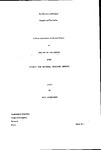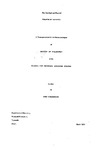The Chemical and Physical Properties of Tourmaline
| dc.contributor.author | HENDERSON, ERIC | |
| dc.contributor.other | School of Geography, Earth and Environmental Sciences | en_US |
| dc.date.accessioned | 2013-09-18T12:33:18Z | |
| dc.date.available | 2013-09-18T12:33:18Z | |
| dc.date.issued | 1971 | |
| dc.identifier | NOT AVAILABLE | en_US |
| dc.identifier.uri | http://hdl.handle.net/10026.1/1858 | |
| dc.description.abstract |
The decomposition temperature of schorl was found to be 880 ± 10°C using X-ray and optical methods. The main crystalline product in decomposed schorl and dravite was found to be a boron containing mullrte, the composition of this phase was found to become closer to that of mullite (3Al203.2Si02) as the decomposition temperature was increased. The size of these possibly slightly.orientated needle shaped microcrystals was approximately 25 ± 10 u by 3 ± 2 u by 3 ± 2 u. The main decompostion products obtained in reducing conditions, in addition to the boron containing mudite, were hercynite {FeO-Al203} at low temperatures and oC— iron at higher temperatures. The decomposition temperature:; of schorl in the presence of activated charcoal was found to be at least 60^C lower than that for air decomposed schorl. This decrease was thought to be associated wcth the formation of hercynite by a low temperature reaction between schorl and activated charcoal. The boric oxide and Iron oxide in air decomposed schorl were both extracted by dilute acid. The rate of extraction was found to increase as the original schorl decomposition temperature was increased. The activation energy for the extraction of boric oxide as a function of the schorl decomposition temperature was found to be equal to 19.2 ± 0.4 kcal/mole. This increase in the rate of extraction of boric oxide was suggested to be associated with the separation and growth of micro-regions of a boron rich phase within the silica-iron oxide amorphous matrix. The activation energy for the extraction of boric oxide as a function of the leaching temperature was found to be equal to 7.99 ± 0.19 kcal/mole, whilst the activation energy for the extraction of iron oxide from air decomposed schorl was found to be equal to 7.13 ± 1.06 kcal/mole. The similarity between these values and that of 6.8 kcal/mole for the activation energy oftacTid leaching of phase-separated borosilicate glass (138), was thought to provide further indirect evidence for the suggestion that the amorphous phase in decomposed schorl contains phase separated micro-regions. The rate of extraction of both boric oxide and iron from schorl decomposed in reducing conditions was found to be considerably faster than from air decomposed schorl. This increased extractability was thought to be connected with the presence of micro-crystals of iron in the decomposed reduced schorl. The boric oxide present in both schorl and dravlte was found to be extractable if water vapour was passed over the decomposed minerals at temperatures above 1000*c. The activation energy for the extraction of boric oxide by pyrohydrolysis from decomposed schorl was found to be equal to 85 ± 8 kcal/mole, whilst the activation energy for the extraction of boric oxide by pyrohydrolysis from both decomposed dravite and "pyrex" glass was found to be equal to 22 ±1 kcal/mole. The higher value was thought to be due to the incorporation of Fe2+ ions into the amorphous silica lattice in decomposed schorl. This process was suggested to lead to an increase in the energy barrier towards the diffusion of water vapour through the silica-iron oxide amorphous matrix to the boron rich reaction surface. | en_US |
| dc.language.iso | en | en_US |
| dc.publisher | University of Plymouth | en_US |
| dc.title | The Chemical and Physical Properties of Tourmaline | en_US |
| dc.type | Thesis | |
| plymouth.version | Full version | en_US |
| dc.identifier.doi | http://dx.doi.org/10.24382/4614 | |
| dc.identifier.doi | http://dx.doi.org/10.24382/4614 |
Files in this item
This item appears in the following Collection(s)
-
01 Research Theses Main Collection
Research Theses Main



